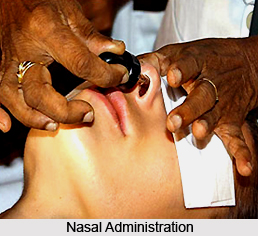 Panchakarma is Ayurveda"s primary purification and detoxification treatment. Panchakarma literally signifies the "Five Therapies". It is an all-inclusive system of knowledge and practices to remove toxins from the body and restore the body"s harmony with nature. These five curative means of eliminating toxins from the body are;
Panchakarma is Ayurveda"s primary purification and detoxification treatment. Panchakarma literally signifies the "Five Therapies". It is an all-inclusive system of knowledge and practices to remove toxins from the body and restore the body"s harmony with nature. These five curative means of eliminating toxins from the body are;
•Vamana,
•Virechana,
•Nasya,
•Basti and
•Raktamokshana.
Vamana or Emesis Therapy: When there is blockage in the lungs leading to recurrent attacks of bronchitis, colds, cough or asthma, the Ayurvedic treatment is therapeutic vomiting or Vamana, to eliminate the kapha that is responsible for the deposition of the excess mucus within the body.
Virechana or Purgation Therapy: When excess of bile or pitta is secreted, it often gets accumulated in the gall bladder, liver and small intestine. This in turns results in rashes, spots, skin inflammation, persistent attacks of fever, vomiting, feeling of nausea and jaundice. In such cases, therapeutic purgation or virechana helps to normalise the bodily activities.
Basti or Enema Therapy: Ayurvedic basti involves the introduction of herbal preparations of sesame oil and the like into the rectum. It relieves chronic fever, constipation, cold, sexual disorders, heart pain, kidney stones, backache, sciatica and other pains in the joints. Many other vata disorders such as rheumatism, arthritis, gout, muscle spasms and headaches may also be cured through basti.
Nasya or Nasal Administration: The administration of medication through the nasal passage is called Nasya. A surplus of bodily humours accumulated in the sinus, throat, nose or head areas is eliminated by means of Nasya.
Raktamokshana: Toxins present in the gastro-intestinal tract get mixed with blood and are circulated throughout the body. The body suffers from various skin disorders. In such cases, the purification of blood or raktamoksha becomes necessary along with internal medication. Raktamoksha is also followed in case of ailments like enlarged liver, spleen and gout.
They facilitate the removal of toxins that cause anxiety and illness, and also restore the proper balance of the three doshas. If it is done properly, appropriate healing along with lucid intelligence, sharpness of the senses, stability of the body, normalized capability of digestion and absorption, prolongation of youth are all achieved. Panchakarma is in fact only a part of a group of remedial measures belonging to a set of purification procedures called "Shodhana".
Process of Panchakarma
Panchakarma includes three serial procedures. These are;
1. Purva Karma (Preparatory Methods) which constitutes Paachan (Digestion), Snehana (Internal and external oleation) and Swedan (Fomentation),
2. Pradhan Karma (Main methods) which comprises Vamana (Induced vomiting), Virechana (Induced purgation), Basti (Medicated enema), Nasya (Nasal medicine) and Raktamokshana (Artificial bloodletting),
3. Paschat Karma (Post-Therapeutic Measures) which consists of Sansarjan Karma (Specific dietetics) and Rasayana (rejuvenation therapy).
Purva Karma: It refers to the procedures that prepare the body for Pradhan Karma, the main stage of Panchakarma. It includes Paachan (Digestion), Snehana (Internal and external oleation) and Swedan (Fomentation).
Pradhan Karma: Pradhan karma constitutes the main step of Panchakarma and includes five main procedures of cleansing the body. Pradhan karma comes after Purva Karma and constitutes the five procedures of Vamana (Induced vomiting), Virechana (Induced purgation), Basti (Medicated enema), Nasya (Nasal medicine) and Raktamokshana (Artificial bloodletting).
Paschat Karma: Paschat karma is a third and concluding phase of Panchakarma. After Panchakarma the procedures Sansarjan Karma and Rasayana are followed. Sansarjan karma involves the administration of a special diet that strengthens the digestive power of the patient. Rasayana includes rejuvenating methods that must be undertaken after all the five main procedures or Pradhan Karma has been completed. If this process is followed after Pradhan Karma, then the patient experiences an amplified energy level, strengthened immune system and increased longevity.
Panchakarma is of enormous importance in Ayurveda because it covers a wide range of preventive and curative measures. This process eliminates the deep-seated toxins from the body thus helping the body to regain its normal potential. Due to its immense utility, Panchakarma has been given a special place in all the ancient Ayurvedic texts. Acharya Charaka, the writer of the most important ancient text on internal medicine, lays down various uses of Panchakarma therapy for almost every major disease. Two separate sections in "Charaka Samhita", "Kalpa Sthanam" and "Siddhi Sthanam" extensively discuss the procedures of Panchakarma.





